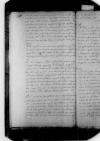List #5746
Alfonso de VALDÉS do Ioannes DANTISCUSPalencia, [1527]-09-24
Regest polski: Valdes cieszy się, że Dantyszek wyzdrowiał. Wbrew jego spodziewaniom Aleksander [von Schweiß?] nie uzyskał nic od pana de Nassau. Valdes zachęca Dantyszka, aby, jeśli przybędzie do Palencji, nie zatrzymywał się w gospodzie, zaprasza go do własnej kwatery. U cesarza nie udało się uzyskać zakwaterowania nawet szczególnie zapobiegliwemu posłowi portugalskiemu [...]. Valdes zapewnia, że nie miał żadnych kłopotów po tym, jak ostatnio gościł Dantyszka. Nie miał listu od kanclerza [Mercurino Gattinary]. Kanclerz miał dotrzeć do Saragossy w miniony poniedziałek [23 września], nie można więc spodziewać się go wcześniej niż w ciągu 8-10 dni. Valdes zdecydował się pozostać w Palencji do następnej niedzieli lub poniedziałku w oczekiwaniu na wieści od kanclerza. Powiadomi Dantyszka, co należy czynić. Z Węgier nadeszły mało wiarygodne wiadomości o pokonaniu wojewody [Jana Zapolyi] i zdobyciu Budy przez [arcyksięcia] Ferdynanda. Wszyscy oczekują zawarcia pokoju [między cesarstwem a Francją], Valdes jednak nie spodziewa się, aby miało to szybko nastąpić. Przekazuje pozdrowienia od gospodarza [siebie samego?] i Jana.
| odebrano Paredes de Nava, [1527]-09-24 Rękopiśmienne podstawy źródłowe:
Pomocnicze podstawy źródłowe:
Publikacje:
| ||||||||||||||||||
Tekst + aparat krytyczny + komentarzZwykły tekstTekst + komentarzTekst + aparat krytyczny
print 1 Clarissimo viro, domino Ioanni Dantisco, serenissimi regis Poloniae oratori etc.,
ms 1 2 omitted⌈Clarissimo viro, domino
ms 1 2 omitted⌉
Pristinae valetudini te restitutum gaudeo. Sperabam probably
ms 1 2 Nassau⌈Nassouprint 1 Nassou,
ms 1 2 Nassau⌉probably
ms 1 (ut audio),
ms 2 ut audio⌈ut audioprint 1 ut audio,
ms 1 (ut audio),
ms 2 ut audio⌉, nihil hactenus factum est. Nosti
ms 1 2 habito⌈habitaprint 1 habita,
ms 1 2 habito⌉[1] diversorio, vide, ne antiquo hospiti[2]
iniuriam facias. Nam si in primo cubiculo lectum print 1 tuum,
ms 1 2 suum⌈tuumprint 1 tuum,
ms 1 2 suum⌉
collocare nolueris, erit non incommodus locus in secundo, ubi nullus
dor BK 222, No. 55, p. 203mit, nec alicui incommodo esse poteris. De impetrando a
BK 222, No. 55, p. 203mit, nec alicui incommodo esse poteris. De impetrando a
A
print 1 Caesaraugustanos⌈Caesaraugustanusms 1 2 Caesaraugustanus,
print 1 Caesaraugustanos⌉probably
ms 1 Dom[i]nicam hidden by binding,
ms 2 Dominicam⌈Dominicumprint 1 Dominicum,
ms 1 Dom[i]nicam hidden by binding,
ms 2 Dominicam⌉ vel Lunae. Quod faciendum erit, in tempore ex me print 1 faxo,
ms 1 2 fixo⌈faxoprint 1 faxo,
ms 1 2 fixo⌉,
ut habeas.
Nihil est, quod verearis mihi incommodi futurum, quod tibi hospitium communicaverim. Non tam insaniunt alcaldi print 1 nostri,
ms 1 nostr[i] hidden by binding,
ms 2 nostri⌈nostriprint 1 nostri,
ms 1 nostr[i] hidden by binding,
ms 2 nostri⌉. Ego quidem nec verbum ullum de hac re audivi; quodsi ob eam rem
aliquid ferendum esset, ferrem equidem animo iucundissimo.
De rebus Ungaricis audivi
ms 1 waywoda[m] hidden by binding,
ms 2 waywodam⌈vayvodamprint 1 vayvodam,
ms 1 waywoda[m] hidden by binding,
ms 2 waywodam⌉
ms 1 2 et⌈acprint 1 ac,
ms 1 2 et⌉ frigide mihi relatum est, ut nullam apud me fidem print 1 habuerit,
ms 1 haberit,
ms 2 habuerit⌈habueritprint 1 habuerit,
ms 1 haberit,
ms 2 habuerit⌉,
aliud certe audivi nihil. Nihil praeterea rerum novarum apud nos est.
Omnes print 1 avide,
ms 1 avidi,
ms 2 avide⌈avideprint 1 avide,
ms 1 avidi,
ms 2 avide⌉
pacem sperant illamque factam esse multi existimant, ego vero, qui meorum
print 1 omitted⌈unams 1 2 una,
print 1 omitted⌉ cum tuo probably
ms 1 2 Palentiae⌈Palantiaeprint 1 Palantiae,
ms 1 2 Palentiae⌉
ms 1 XXIIII,
ms 2 vigesima quarta⌈XXIIIIprint 1 XXIIII,
ms 1 XXIIII,
ms 2 vigesima quarta⌉ Septembris.
Postscript:
Scribe, an tuis globulis aureis aliquid expiscaveris.
ms 1 2 omitted⌈Tuus, quicquid est, Valdesiusprint 1 Tuus, quicquid est, Valdesius,
ms 1 2 omitted⌉

